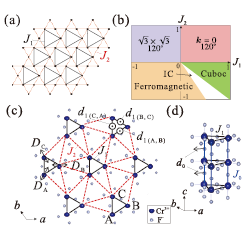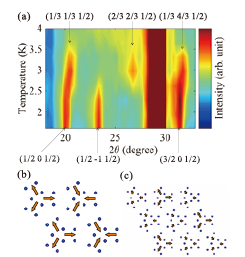Magnetic States of Coupled Spin Tubes with Frustrated Geometry in CsCrF4
Masuda Group
When a theoretical model is realized in nature, small perturbation terms play important roles in the selection of the ground state in geometrically frustrated magnets. In case of a triangular spin tube, the two-dimensional network of the inter-tube interaction forms characteristic lattices. Among them Kagome-Triangular (KT) lattice in Fig. 1(a) is known to exhibit an enriched phase diagram [1] including various types of non-trivial structures: non-coplanar cuboc structure, coplanar 120º structure with the two-dimensional propagation vector of k2D = 0, √3×√3 structure with k2D = (1/3, 1/3), and incommensurate structure as shown in Fig. 1(b). We investigate the magnetic state in the model material CsCrF4 in Fig. 1(c) and 1(d) by using neutron diffraction technique. Temperature evolution of the diffraction profile was collected as shown in Fig. 2(a). Combination of representation analysis and Rietveld refinement reveals that a very rare structure, i.e., a quasi-120º structure with k2D = (1/2, 0) in Fig. 2(b), is realized at the base temperature. The classical calculation of the phase diagram elucidates that CsCrF4 is the first experimental realization of the KT lattice having ferromagnetic Kagome bond. A single-ion anisotropy and Dzyaloshinskii-Moriya interaction play key roles in the selection of the ground state. Furthermore, a successive phase transition having an intermediate state represented by k2D = (1/3, 1/3) is observed. The intermediate state is a partially ordered 120º structure in Fig. 2(c) [2].

Fig. 1. Coupled spin tubes with frustrated geometry. (a) Kagome-Triangular (KT) lattice. J1 is the Triangular bond and J2 is the Kagome bond. (b) Phase diagram of the KT lattice. (c), (d) The crystal structure of CsCrF4. Blue and small gray circles represent Cr3+ and F- ions, respectively. J1 is the Triangular bond and J2 is the Kagome bond. The d1({α,β)} is DM vector (α,β = A,B,C). zA, zB, and zC are the z-axes locally defined on the Cr sites, A, B, and C. Spin tube runs along the c axis in (d), and the tubes form the KT lattice in the a - b plane in (c).

Fig. 2. Magnetic neutron diffraction profile and magnetic structures. (a) The temperature variation of diffraction profiles in the range of 2θ = 18º-33º. (b), (c) Candidates of the magnetic structures of CsCrF4 for the ground state (b) and the intermediated state (c).
This study was originally initiated for the neutron study of the Tomonaga-Luttinger liquid predicted in a spin tube using JRR-3 research reactor before east Japan earthquake in 2010. Since the magnetic state is sensitive to impurity in the titled compound, we need to check the reproducibility of the data carefully. As a result, the quality of some samples used at JRR-3 were not good, and we needed to redo the experiment on selected high-quality sample using foreign neutron facilities after 2010. All of the published data in Ref. [2] were, thus, collected at ECHIDNA spectrometer in ANSTO Australia. Furthermore, the difficulty of the transportation of radioactive material such as Cs after the earthquake made the situation complicated. Thanks to many people including scientists, technicians, and office staff, we completed the project.
References
- [1] H. Ishikawa et al., J. Phys. Soc. Jpn 83, 043703 (2014).
- [2] M. Hagihala et al., npj Quantum Materials 4, 14 (2019).
